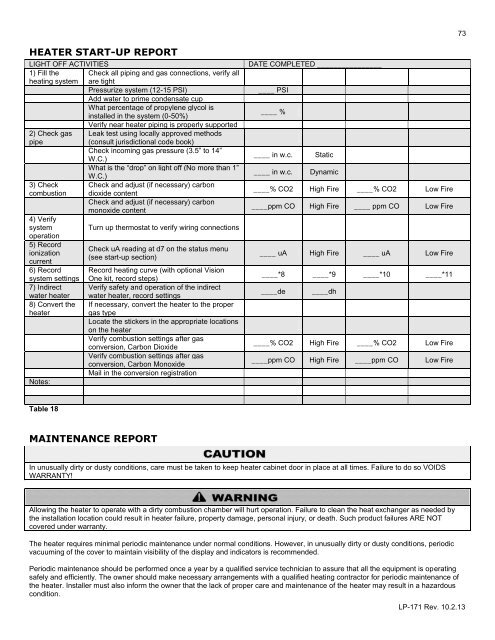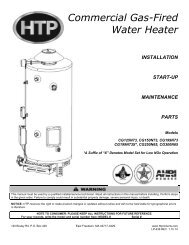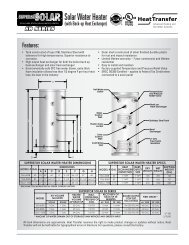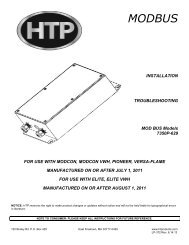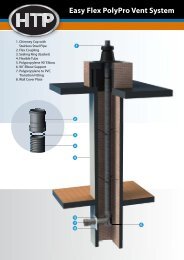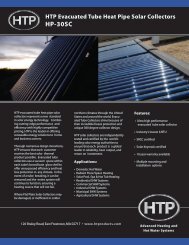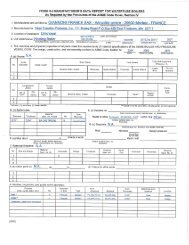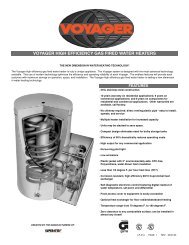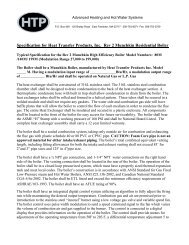MC Series Gas-Fired Circulating Heater - Heat Transfer Products, Inc
MC Series Gas-Fired Circulating Heater - Heat Transfer Products, Inc
MC Series Gas-Fired Circulating Heater - Heat Transfer Products, Inc
You also want an ePaper? Increase the reach of your titles
YUMPU automatically turns print PDFs into web optimized ePapers that Google loves.
73<br />
HEATER START-UP REPORT<br />
LIGHT OFF ACTIVITIES<br />
1) Fill the Check all piping and gas connections, verify all<br />
heating system are tight<br />
Pressurize system (12-15 PSI)<br />
Add water to prime condensate cup<br />
What percentage of propylene glycol is<br />
installed in the system (0-50%)<br />
2) Check gas<br />
pipe<br />
3) Check<br />
combustion<br />
4) Verify<br />
system<br />
operation<br />
5) Record<br />
ionization<br />
current<br />
6) Record<br />
system settings<br />
7) Indirect<br />
water heater<br />
8) Convert the<br />
heater<br />
Notes:<br />
Verify near heater piping is properly supported<br />
Leak test using locally approved methods<br />
(consult jurisdictional code book)<br />
Check incoming gas pressure (3.5” to 14”<br />
W.C.)<br />
What is the “drop” on light off (No more than 1”<br />
W.C.)<br />
Check and adjust (if necessary) carbon<br />
dioxide content<br />
Check and adjust (if necessary) carbon<br />
monoxide content<br />
Turn up thermostat to verify wiring connections<br />
Check uA reading at d7 on the status menu<br />
(see start-up section)<br />
Record heating curve (with optional Vision<br />
One kit, record steps)<br />
Verify safety and operation of the indirect<br />
water heater, record settings<br />
If necessary, convert the heater to the proper<br />
gas type<br />
Locate the stickers in the appropriate locations<br />
on the heater<br />
Verify combustion settings after gas<br />
conversion, Carbon Dioxide<br />
Verify combustion settings after gas<br />
conversion, Carbon Monoxide<br />
Mail in the conversion registration<br />
DATE COMPLETED ________________<br />
____ PSI<br />
____ %<br />
____ in w.c. Static<br />
____ in w.c. Dynamic<br />
____% CO2 High Fire ____% CO2 Low Fire<br />
____ppm CO High Fire ____ ppm CO Low Fire<br />
____ uA High Fire ____ uA Low Fire<br />
____*8 ____*9 ____*10 ____*11<br />
____de ____dh<br />
____% CO2 High Fire ____% CO2 Low Fire<br />
____ppm CO High Fire ____ppm CO Low Fire<br />
Table 18<br />
MAINTENANCE REPORT<br />
In unusually dirty or dusty conditions, care must be taken to keep heater cabinet door in place at all times. Failure to do so VOIDS<br />
WARRANTY!<br />
Allowing the heater to operate with a dirty combustion chamber will hurt operation. Failure to clean the heat exchanger as needed by<br />
the installation location could result in heater failure, property damage, personal injury, or death. Such product failures ARE NOT<br />
covered under warranty.<br />
The heater requires minimal periodic maintenance under normal conditions. However, in unusually dirty or dusty conditions, periodic<br />
vacuuming of the cover to maintain visibility of the display and indicators is recommended.<br />
Periodic maintenance should be performed once a year by a qualified service technician to assure that all the equipment is operating<br />
safely and efficiently. The owner should make necessary arrangements with a qualified heating contractor for periodic maintenance of<br />
the heater. Installer must also inform the owner that the lack of proper care and maintenance of the heater may result in a hazardous<br />
condition.<br />
LP-171 Rev. 10.2.13


